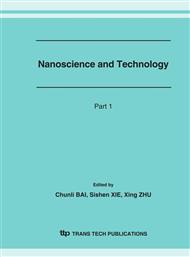p.1161
p.1165
p.1171
p.1175
p.1181
p.1189
p.1193
p.1199
p.1203
Surface-Area-Difference Model for Melting Temperature of Metallic Nanocrystals Embedded in a Matrix
Abstract:
The cohesive energy is the energy to divide the crystal into isolated atoms, and the direct result of cohesive energy is to create new surface. The increased surface energy should equal the cohesive energy of the crystal, which results from the surface area difference between the total atoms and the crystal. This is the basic concept of Surface-Area-Difference (SAD) model. The SAD model has been extended to account for the melting temperature of metallic nanocrystals with non-free surface (embedded in a matrix) in the present work. It is shown if the melting temperature of the matrix must be much higher than that of the bulk value of the nanocrystals, and the nanocrystals has coherent or semi-coherent interface with the matrix, the nanocrystals may be superheated. The present results are supported by the available experimental values.
Info:
Periodical:
Pages:
1181-1188
Citation:
Online since:
March 2007
Authors:
Price:
Сopyright:
© 2007 Trans Tech Publications Ltd. All Rights Reserved
Share:
Citation:


